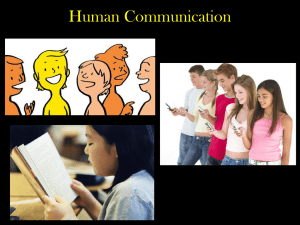Language and brain: historical introduction to models of language
advertisement
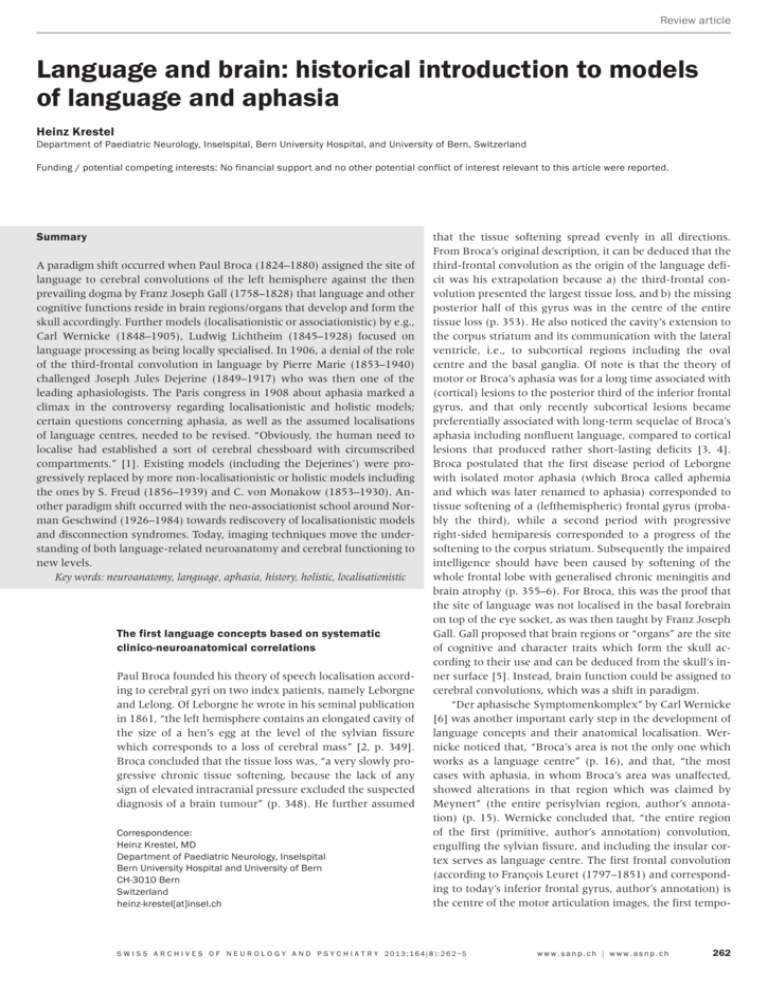
Review article Language and brain: historical introduction to models of language and aphasia Heinz Krestel Department of Paediatric Neurology, Inselspital, Bern University Hospital, and University of Bern, Switzerland Funding / potential competing interests: No financial support and no other potential conflict of interest relevant to this article were reported. Summary A paradigm shift occurred when Paul Broca (1824–1880) assigned the site of language to cerebral convolutions of the left hemisphere against the then prevailing dogma by Franz Joseph Gall (1758–1828) that language and other cognitive functions reside in brain regions/organs that develop and form the skull accordingly. Further models (localisationistic or associationistic) by e.g., Carl Wernicke (1848–1905), Ludwig Lichtheim (1845–1928) focused on language processing as being locally specialised. In 1906, a denial of the role of the third-frontal convolution in language by Pierre Marie (1853–1940) challenged Joseph Jules Dejerine (1849–1917) who was then one of the leading aphasiologists. The Paris congress in 1908 about aphasia marked a climax in the controversy regarding localisationistic and holistic models; certain questions concerning aphasia, as well as the assumed localisations of language centres, needed to be revised. “Obviously, the human need to localise had established a sort of cerebral chessboard with circumscribed compartments.” [1]. Existing models (including the Dejerines’) were progressively replaced by more non-localisationistic or holistic models including the ones by S. Freud (1856–1939) and C. von Monakow (1853–1930). Another paradigm shift occurred with the neo-associationist school around Norman Geschwind (1926–1984) towards rediscovery of localisationistic models and disconnection syndromes. Today, imaging techniques move the understanding of both language-related neuroanatomy and cerebral functioning to new levels. Key words: neuroanatomy, language, aphasia, history, holistic, localisationistic The first language concepts based on systematic clinico-neuroanatomical correlations Paul Broca founded his theory of speech localisation according to cerebral gyri on two index patients, namely Leborgne and Lelong. Of Leborgne he wrote in his seminal publication in 1861, “the left hemisphere contains an elongated cavity of the size of a hen’s egg at the level of the sylvian fissure which corresponds to a loss of cerebral mass” [2, p. 349]. Broca concluded that the tissue loss was, “a very slowly progressive chronic tissue softening, because the lack of any sign of elevated intracranial pressure excluded the suspected diagnosis of a brain tumour” (p. 348). He further assumed Correspondence: Heinz Krestel, MD Department of Paediatric Neurology, Inselspital Bern University Hospital and University of Bern CH-3010 Bern Switzerland heinz-krestel[at]insel.ch that the tissue softening spread evenly in all directions. From Broca’s original description, it can be deduced that the third-frontal convolution as the origin of the language deficit was his extrapolation because a) the third-frontal convolution presented the largest tissue loss, and b) the missing posterior half of this gyrus was in the centre of the entire tissue loss (p. 353). He also noticed the cavity’s extension to the corpus striatum and its communication with the lateral ventricle, i.e., to subcortical regions including the oval centre and the basal ganglia. Of note is that the theory of motor or Broca’s aphasia was for a long time associated with (cortical) lesions to the posterior third of the inferior frontal gyrus, and that only recently subcortical lesions became preferentially associated with long-term sequelae of Broca’s aphasia including nonfluent language, compared to cortical lesions that produced rather short-lasting deficits [3, 4]. Broca postulated that the first disease period of Leborgne with isolated motor aphasia (which Broca called aphemia and which was later renamed to aphasia) corresponded to tissue softening of a (lefthemispheric) frontal gyrus (probably the third), while a second period with progressive right-sided hemiparesis corresponded to a progress of the softening to the corpus striatum. Subsequently the impaired intelligence should have been caused by softening of the whole frontal lobe with generalised chronic meningitis and brain atrophy (p. 355–6). For Broca, this was the proof that the site of language was not localised in the basal forebrain on top of the eye socket, as was then taught by Franz Joseph Gall. Gall proposed that brain regions or “organs” are the site of cognitive and character traits which form the skull according to their use and can be deduced from the skull’s inner surface [5]. Instead, brain function could be assigned to cerebral convolutions, which was a shift in paradigm. “Der aphasische Symptomenkomplex” by Carl Wernicke [6] was another important early step in the development of language concepts and their anatomical localisation. Wernicke noticed that, “Broca’s area is not the only one which works as a language centre” (p. 16), and that, “the most cases with aphasia, in whom Broca’s area was unaffected, showed alterations in that region which was claimed by Meynert” (the entire perisylvian region, author’s annotation) (p. 15). Wernicke concluded that, “the entire region of the first (primitive, author’s annotation) convolution, engulfing the sylvian fissure, and including the insular cortex serves as language centre. The first frontal convolution (according to François Leuret (1797–1851) and corresponding to today’s inferior frontal gyrus, author’s annotation) is the centre of the motor articulation images, the first tempo- S W I S S A R C H I V E S O F N E U R O L O G Y A N D P S Y C H I A T R Y 2013;164(8):262–5 www.sanp.ch | www.asnp.ch 262 Review article ral convolution […] is the centre of the sound images, the fibrae propriae, radially converging in the insula, form the psychic reflex arc. (p. 18–19) Wernicke at first did not relate his fibrae propriae to the (superior longitudinal fasciculus/) arcuate fasciculus (SLF/AF) described previously by Friedrich Burdach (1776–1847) and Johann Christian Reil (1759–1813). Wernicke wrote, “that to his knowledge, the fibrae propriae had not been described elsewhere, but provide major evidence for the relevance of the first primitive convolution, converge radially into the insula, thereby giving the insula the impression of a functional centre (p. 17).” Wernicke was not to correct his view until 1908 that the idea of a psychic reflex arc and assumedly the fibrae propriae corresponded to the AF [7, 8]. The high degree of connectivity of the perisylvian region and particularly of the claustrum appeared as a good anatomical prerequisite for the localisation of language to Wernicke, who explicitly adapted the idea of the perisylvian region (the claustrum was believed by Meynert to be the accustic cortex which is now known to reside in Heschl’s cortex in the superior temporal gyrus) from Theodor von Meynert (1833–1892). The same reasoning of the claustrum’s intense connectivity was used 150 years later as a potential indicator for the site of consciousness which is now believed (at least for viscero-somatic afferences) to reside in the anterior insula [9, 33]. Ludwig Lichtheim (1845–1928) was Professor of Medicine at Bern university hospital when he wrote his work “Über Aphasie” [10] that was built in particular on the publications of Broca, Wernicke and Adolf Kussmaul (1822– 1902). To the author’s knowledge, Lichtheim was the first who introduced a systematic analysis of language abilities such as spontaneous speech, speech and writing comprehension, spontaneous writing, dictation writing, writing copying, loud reading and speech repetition. He classified language disorders into seven aphasias [10, pp. 220–37]. Lichtheim localised the causative lesions of his aphasias to known neuroanatomical structures. His publication did not mention own neuroanatomical studies. The famous Wernicke-Lichtheim model, valid far into the 20th century, was generated when Wernicke adapted Lichtheim’s aphasia classification. Wernicke left Lichtheim’s functional attribution to neuroanatomical sites essentially unchanged but modified the terminology of the aphasias [11]. Aphasia: a localisationistic versus holistic view of higher brain functions “The third frontal convolution does not play any particular role in language functions (‘la fonction du language’),” [12] in France, in 1906, this dictum turned Pierre Marie into a maverick of aphasiology, which was then shaped by Joseph Jules Dejerine [13–15]. The Dejerines’ model of language and aphasia, formed and published by Dejerine together with his wife Augusta Dejerine-Klumpke between 1895 and 1902, consisted of an intricate network of cortical language centres and association fibres in the left hemisphere [7]. Language arose as a network function. Aphasia arose from any lesion within the language zone and hampered all language modes to a variable degree, dependent on the lesion localisation. Nevertheless, the Dejerines’ model was regarded as localisationistic which was amongst others related to the perception of Joseph Jules Dejerine as chair of the clinic for diseases of the nervous system, and his remaining scientific work including his publications about alexia without agraphia which was one of the classical disconnection syndromes with a defined lesion localization [7]. Language models were categorised as either localisationistic (including associationistic models), or holistic, based on whether they focused on language processing as being locally specialised (without/with interconnected brain regions) or less tightly allocated to distinct brain regions, respectively. Pierre Marie, who would later be a forerunner of holistic psychology, turned away from the so-called localisationalists, or diagram makers, who, according to his opinion, did not correctly interpret anatomopathologial data. He regarded even his former supervisor, Paul Broca, who had identified the left frontal lobe as a faculty of language, as a localisationalist. The question, whether a cerebral localisation of higher, or in the broadest sense intellectual, brain functions existed and if so to what extent, formed the background of the controversy about aphasia. This basic conflict affected European brain research for the entire 19th century and paved the way for trends in neuroscience for the 20th century. Localisationistic thinking began with Franz Joseph Gall’s phrenology, which assigned character traits to defined brain regions that develop, form the skull, and can thus be recognised from the skull’s inner surface [5]. Paul Broca’s publication in 1861 was the first to localise a clinical deficit of convolutions in the brain [16, p. 141]. This publication heralded a scientific revolution and also created a dilemma. Until then, the cerebral cortex, with its convolutions, had been reserved for higher brain functions, i.e., for all abilities that distinguished man from animal. Broca’s publication linked brain convolutions with an ability that was regarded as a motor function, thereby violating this dogma and, at the same time, opening the door for further anatomical and experimental research. It was speculated that language was either a circumscribed pure motor function or that it indicated a higher, more complex intellectual function. It seemed bold to restrict the latter function to certain brain regions. According to Young [16, p. 144], Broca would rather accept the dogma of being able to localise higher brain functions than to accept the idea that language could be represented in the human cerebral cortex as a motor, i.e., inferior, function. It was clear to Broca and his disciples that language was a faculty of its own within brain functions. The basic principles of this view were supported by Carl Wernicke’s work “Der aphasische Symptomenkomplex” [6] and became generally accepted until the present time. By 1870, Fritsch and Hitzig showed experimentally what had been observed in principle by Hughlings Jackson and others before i.e., that a dog’s telencephalon could be locally excited and result in certain motor actions [16, p. 7]. These experiments supported the idea that at least simple functions of the brain could be localised. Pierre Marie had to insist that Wernicke’s aphasia was accompanied by impaired intelligence because Marie denied defined cortical centres of speech, and hence also a disturbance of inner language, as Joseph Jules Dejerine described it. In contrast, Joseph Jules Dejerine was not a rigorous lo- S W I S S A R C H I V E S O F N E U R O L O G Y A N D P S Y C H I A T R Y 2013;164(8):262–5 www.sanp.ch | www.asnp.ch 263 Review article calisationalist, particularly not in his aphasia research. He had already employed the concept of functional systems, often using the terms zone or region rather than a name of a circumscribed brain region [17, 18]. The deployment of individual models of language and aphasia was of course not strictly sequential, but partially overlapping and coincidental. An interesting overview over the metamorphose of the language zone from Franz Joseph Gall to Wilder Penfield (1891–1976) is given elsewhere [19, p. 297 ff]. The Paris congress in 1908 marked a climax in the controversy regarding localisationistic and holistic models. At that time, several questions could not be explained with the then existing models, including that of the Dejerines. For example, the existing models could not explain why injury to anatomically distinct language regions could give rise to apparently unpredictable and overlapping symptoms. Because of these issues, the existing models were progressively replaced by more non-localisationistic or holistic ones [12, 20–23]. Examples for holistically perceived models include the one by Sigmund Freud [20]. Freud criticized the Wernicke-Lichtheim scheme (p. 10) and the concept of inner language (p. 20). He rejected the classification into cortical and conduction aphasia (p. 19) and the explanation that the variety of aphasias can be explained by different localisations of destructive lesions (p. 20, 31). Instead, he accepted the existence of a continuous, left hemispheric cortex area as a language zone. Freud added to the lesion hypothesis a theory of functional impairment of language centres, in which he referred to the grading scheme from normal neuronal excitability to non-excitability by Henry Charlton Bastian (1837–1915). Freud proposed that the assumption of a loss of language function by destructive lesions in certain centres or trajectories is invalid for particular forms of aphasia including transcortical motor aphasia. Instead, certain language deficits can be better explained by a graded change in function of language centres that are partially lesioned but not fully destroyed (p. 45). He also accepted the concept of a more topical, i.e., selective impairment of certain language functions by lesions at the language zone’s boundary, while all language functions were affected to a different extent by lesions in the language zone’s centre [20, p. 106]. Another holistically perceived model was the one by Constantin von Monakow (1853–1930), first Swiss chair for anatomical subjects of the brain and neurological polyclinic (“hirnanatomische Fächer und Nervenpolylinik”), cofounder of the Swiss Society of Neurology, and founder of the Swiss Archives for Neurology and Psychiatry. His model encompassed a lefthemispheric language zone whose extension was very similar to the Dejerines’ model [21, 24]. Von Monakow however added his concepts of diaschisis and (neuronal) plasticity to better explain the temporal course of language disorders: the recovery of language after brain injury or stroke may be explained by the reactivation of cortical long-range efforts (diaschisis) outside the left hemispheric language zone and the right hemisphere. An improved utilisation of existing left- and right hemispheric trajectories outside the proper language zone together with the creation of new connections with the left hemispheric language centres (plasticity) may add to language recovery, as well. These convictions, and other issues [7], were the reasons, why von Monakow was perceived as a holist while Joseph Jules Dejerine was perceived as a localisationalist. In summary, the localisationistic, along with the holistic view, of brain functions, in general, prevailed into the 21st century, developing into established fields of neurology, neuroradiology and neurosurgery on the one hand, as well as psychology and psychiatry on the other hand. Linguistic, neo-associationistic, neuropsychological and clinico-radiological aspects of language and aphasia The original report by Norman Geschwind, founder of the neo-associationist school, is very instructive for understanding the course of the history of language research [25]. He wrote that the time between the world wars lead to a loss of interest in localisationistic and association models including disconnection syndromes. The critique by holistically oriented neurologists such as Henry Head (1861–1940), Pierre Marie, von Monakow, and Kurt Goldstein (1878– 1965) contributed heavily to this loss of interest. The rise of holistic psychology under the Gestalt-School and Karl Lashley (1890–1958), as well as the rapid development of holistic psychiatry schools also played a role. The retreat of Joseph Jules Dejerine and Hugo Liepmann (1863–1925), Wernicke’s student and the first to describe apraxia (one of the 4 classical disconnection syndromes namely conduction aphasia, apraxia, agnosia, and alexia without agraphia), from the active scene deprived the classic school of some of its biggest protagonists. When the publications about the missing impact of corpus callosum transection on neurological function in epileptic patients appeared (Akelaitis AJ 1941–45, referenced in [25]), most neurologists, at least in the USA and in Great Britain were willing to reject the classical teachings about the importance of the commissural and interhemispherical association pathways. The tide of interest in the callosum turned, when it was shown, in 1953, that an animal with transcallosal resection showed dramatic behavioural changes, if studied carefully (Myers RE, Sperry RW 1953, referenced in [25]). This led Geschwind and coworkers to reexamine the old literature and reassess their patients for deficits of higher cognitive functions. In 1961–62, they could publish cases with alexia without agraphia (as did Joseph Jules Dejerine) which could be attributed to involvement/lesion of the corpus callosum [25, pp. 239–41]. Geschwind’s lessons from his studies were reported elsewhere in detail [e.g., 26]. In summary, one lesson was the reappraisal, application, and interpretation of the rule of Flechsig. This rule says that primary receptive areas do not have direct neocortical interconnections except to neighbouring association areas. According to Geschwind, a lesion causing a disconnection syndrome can either be located in a cortical association area or in the white matter leading away from the association cortex (pp. 242–4). Another of Geschwind’s lessons was that the inferior parietal gyrus and particularly the angular gyrus has an outstanding role for language. According to Geschwind, this region (Brodmann areas 39, 40) appears so well developed in man that it can almost be regarded as a new anatomical structure. It S W I S S A R C H I V E S O F N E U R O L O G Y A N D P S Y C H I A T R Y 2013;164(8):262–5 www.sanp.ch | www.asnp.ch 264 Review article possesses few thalamic afferent fibers but instead mainly cortical afferents. It is not concentrically arranged around primary receptive fields as are phylogenetically older association areas and thus resembles certain frontal association areas that are largely athalamic, myelinate late, and form dentrites late in development (p. 273). Functionally, the inferior parietal gyrus allows associations between nonlimbic stimuli that form the basis of learning object names. Geschwind however emphasised that, even in man, learning finally depends on intact limbic connections (p. 274). Geschwind examplarily cited that a temporal lesion disconnecting the posterior language region from the limbic system would cause verbal learning difficulties and impair rehabilitation. In further support of this hypothesis, epilepsy surgery with resection of the left anterior temporal lobe would lead to deeper verbal memory impairment than resection of the right anterior temporal lobe (p. 271–2). Taken together, another paradigm shift occurred with the neo-associationist school towards the rediscovery of localisationistic models and disconnection syndromes, which were further advanced. After the persistence of the holistic view for a few decades and prior, coincidental, and subsequent to the neoassociationist school, the fields of neurolinguistics, psycholinguistics, cognitive neuropsychology, and clinic-radiological studies evolved. Neurolinguistics is rooted in aphasiology and analyses the neural mechanisms of human language processing [27]. Psycholinguistics is the study of the psychological and neurobiological factors that enable humans to speak [28]. Cognitive neuropsychology uses box-and-arrow frameworks to explain language tasks and dysfunction. Box and-arrow frameworks are a conceptual advancement of the line diagrams, first used by the diagram makers (an expression going back to Henry Head) including Lichtheim, to explain language function and lesion localisation in aphasia. The box-and-arrow theories (i.e., boxology), developed in the 1970s and 80s, were based on the concepts of modular cognitive systems and transparency. Modularity means that a (language) task can be broken down into a set of component processes. Transparency means that the symptoms of a given neuropsychological disorder are indicators of the underlying component process that has been damaged or the spared normal process being used. Important in the development of these models was the attempt to provide a detailed account of the nature of representations and processing routes involved that allowed the mapping of damage in a given language representation or processing route in a particular patient. With the event and continuous development of cerebral imaging techniques, language-related neuroanatomy moved to a new level of understanding. Clinico-radiological studies of aphasic patients emerged [29, 30] that were and are based on the association of language deficits with cerebral lesions. Functional magnetic resonance imaging (fMRI) and diffusion tensor imaging (DTI, describing fibre tracts implicated in language processing) allowed for the first time the study of language-related neuroanatomy in healthy subjects, as well. The highly sophisticated interpretations from various disciplines allowed the formulation of precise hypotheses regard- ing a putative, multimodal language network that continues to be studied today using imaging techniques and modalities [31, 32]. Remark: All citations are the author’s translations from the original texts in French or German to English. References 1 Klippel M. Deuxième discussion sur l’aphasie. Revue Neurologique. 1908;16:974–1024. 2 Broca P. Remarques sur le siège de la faculté du langage articulé, suivies d’une observation d’aphémie (perte de la parole). Bulletin de la Société Anatomique. 1861;6:330–57. 3 Dronkers NF, Plaisant O, Iba-Zizen MT, Cabanis EA. Paul Broca’s historic cases: high resolution MR imaging of the brains of Leborgne and Lelong. Brain. 2007;130:1432–41. 4 Krestel H, Bassetti C, Jagella C. Augusta Dejerine-Klumpke (1859–1927): Contributions to aphasiology by scientific mobility in the late 19th century. J Neuroling. 2013;26:581–9. 5 Tesak J. Geschichte der Aphasie. 2. Auflage. Idstein: Schulz-Kirchner Verlag GmbH; 2005. 6 Wernicke C. Der aphasische Symptomenkomplex. Breslau: Max Cohn & Weigert; 1874. 7 Krestel H, Annoni JM, Jagella C. White matter in aphasia: A historical review of the Dejerines’ studies. Brain Lang. 2013;127:526–32. 8 Wernicke C. The symptom complex of aphasia. In: Church A (ed.). Diseases of the Nervous System. New York: Appelton; 1908. p. 265–324. [translated from: Wernicke C. Monatsschrift für Psychiatrie und Neurologie, Aprilheft, 1903]. http://archive.org/stream/diseasesnervous00saligoog#page/n292/ mode/1up 9 Crick FC, Koch C. What is the function of the claustrum? Philos Trans R Soc Lond B Biol Sci. 2005;360:1271–9. 10 Lichtheim L. Über Aphasie. Aus der medicinischen Klinik in Bern. Deutsches Archiv für klinische Medicin. München: Bergmann; 1885. p. 204–68. 11 Wernicke C. Einige neuere Arbeiten über Aphasie. Fortschritte der Medizin. 1885;3:824–30 and 1886;4:371–7:463-82. 12 Marie P. Révision de la question sur l’aphasie: La troisième circonvolution frontale gauche ne joue aucun rôle special dans la function du langage. Semaine Médicale. 1906;26:241–7. 13 Dejerine J. L’aphasie sensorielle: sa localisation et sa physiologie pathologique. Presse Med. 1905;55:437–9. 14 Dejerine J. L’aphasie motrice: sa localisation et sa physiologie pathologique, Presse Med. 1906; 57:453–7. 15 Dejerine J. L’aphasie motrice et sa localisation corticale: deux cas d’aphasie motrice par lésion de la circonvolution de Broca. L’Encéphale. 1907;5: 471–520. 16 Young R. Mind, Brain and Adaptation in the Nineteenth Century. Cerebral localization and its biological context from Gall to Ferrier. Oxford: Clarendon Press; 1970. 17 Henderson VW. Jules Dejerine and the Third Alexia. Arch Neurol. 1984;41: 430–2. 18 Bassetti C, Jagella EC. Joseph Jules Dejerine (1849–1917). J Neurol. 2006;253: 823–4. 19 Lecours AR, Lhermitte F. Zone du langage. In: Lecours AR, Lhermitte F (eds.). L’aphasie. Paris: Flammarion; 1979. 20 Freud S. Zur Auffassung der Aphasien. Eine kritische Studie. Leipzig und Wien: Deuticke; 1891. 21 Von Monakow C. Gehirnpathologie. Wien: Hölder; 1905. 22 Goldstein K. Über Aphasie. Beihefte zur «Medizinischen Klinik». 1910;1:1–32. 23 Head H. Aphasia and kindred disorders of speech. 2 Volumes. Cambridge: Macmillan Company; 1926. 24 Von Monakow C. Gehirnpathologie. Wien: Hölder; 1897. 25 Geschwind N. Disconnexion syndromes in animals and man. Brain. 1965;88: 237–94. 26 Catani M, Ffytche DH. The rises and falls of disconnection syndromes. Brain 2005;128:2224–39. 27 Alajouanine T, Ombrédanne A, Durand M. Le Syndrome de Désintégration Phonétique dans l’Aphasie. Paris: Masson; 1939. 28 Marshall JC, Newcombe F. Patterns of paralexia: a psycholinguistic approach. J Psycholinguist Res. 1973;2:175–99. 29 Damasio AR, Geschwind N. The Neural Basis of Language. Ann Rev Neurosci. 1984;7:127–47. 30 Kreisler A, Godefroy O, Delmaire C, Debachy B, Leclercq M, Pruvo JP, et al. The anatomy of aphasia revisited. Neurology. 2000;54:1117–23. 31 Vandenberghe R, Price C, Wise R, Josephs O, Frackowiak RS. Functional anatomy of a common semantic system for words and pictures. Nature. 1996;383:254–6. 32 Hillis AE. Aphasia: progress in the last quarter of a century. Neurology. 2007;69:200–13. 33 Nieuwenhuys R. The insular cortex: a review. Prog Brain Res. 2012;195: 123–63. S W I S S A R C H I V E S O F N E U R O L O G Y A N D P S Y C H I A T R Y 2013;164(8):262–5 www.sanp.ch | www.asnp.ch 265
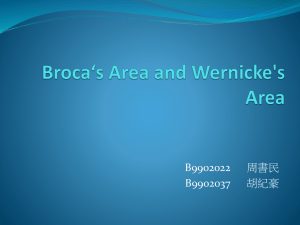
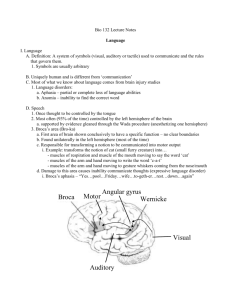

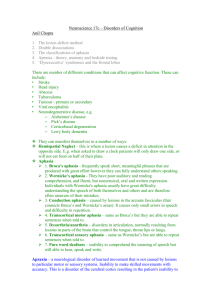
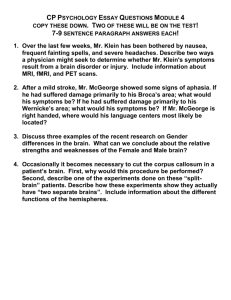
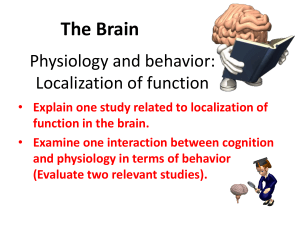
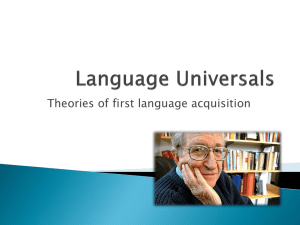
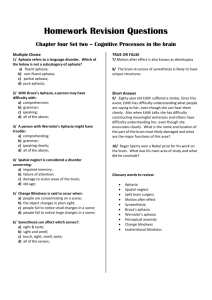
![Wernicke`s_area_presentation[1] (Cipryana Mack)](http://s2.studylib.net/store/data/005312943_1-7f44a63b1f3c5107424c89eb65857143-300x300.png)
